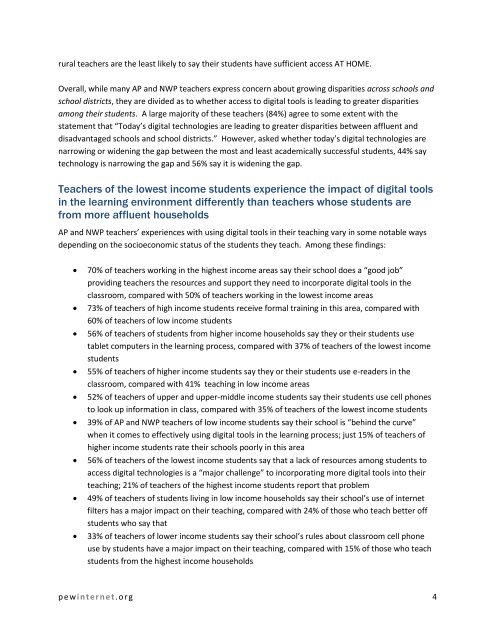How Teachers Are Using Technology at Home and in ... - Prisa Digital
How Teachers Are Using Technology at Home and in ... - Prisa Digital
How Teachers Are Using Technology at Home and in ... - Prisa Digital
Create successful ePaper yourself
Turn your PDF publications into a flip-book with our unique Google optimized e-Paper software.
ural teachers are the least likely to say their students have sufficient access AT HOME.<br />
Overall, while many AP <strong>and</strong> NWP teachers express concern about grow<strong>in</strong>g disparities across schools <strong>and</strong><br />
school districts, they are divided as to whether access to digital tools is lead<strong>in</strong>g to gre<strong>at</strong>er disparities<br />
among their students. A large majority of these teachers (84%) agree to some extent with the<br />
st<strong>at</strong>ement th<strong>at</strong> “Today’s digital technologies are lead<strong>in</strong>g to gre<strong>at</strong>er disparities between affluent <strong>and</strong><br />
disadvantaged schools <strong>and</strong> school districts.” <strong>How</strong>ever, asked whether today’s digital technologies are<br />
narrow<strong>in</strong>g or widen<strong>in</strong>g the gap between the most <strong>and</strong> least academically successful students, 44% say<br />
technology is narrow<strong>in</strong>g the gap <strong>and</strong> 56% say it is widen<strong>in</strong>g the gap.<br />
<strong>Teachers</strong> of the lowest <strong>in</strong>come students experience the impact of digital tools<br />
<strong>in</strong> the learn<strong>in</strong>g environment differently than teachers whose students are<br />
from more affluent households<br />
AP <strong>and</strong> NWP teachers’ experiences with us<strong>in</strong>g digital tools <strong>in</strong> their teach<strong>in</strong>g vary <strong>in</strong> some notable ways<br />
depend<strong>in</strong>g on the socioeconomic st<strong>at</strong>us of the students they teach. Among these f<strong>in</strong>d<strong>in</strong>gs:<br />
70% of teachers work<strong>in</strong>g <strong>in</strong> the highest <strong>in</strong>come areas say their school does a “good job”<br />
provid<strong>in</strong>g teachers the resources <strong>and</strong> support they need to <strong>in</strong>corpor<strong>at</strong>e digital tools <strong>in</strong> the<br />
classroom, compared with 50% of teachers work<strong>in</strong>g <strong>in</strong> the lowest <strong>in</strong>come areas<br />
73% of teachers of high <strong>in</strong>come students receive formal tra<strong>in</strong><strong>in</strong>g <strong>in</strong> this area, compared with<br />
60% of teachers of low <strong>in</strong>come students<br />
56% of teachers of students from higher <strong>in</strong>come households say they or their students use<br />
tablet computers <strong>in</strong> the learn<strong>in</strong>g process, compared with 37% of teachers of the lowest <strong>in</strong>come<br />
students<br />
55% of teachers of higher <strong>in</strong>come students say they or their students use e-readers <strong>in</strong> the<br />
classroom, compared with 41% teach<strong>in</strong>g <strong>in</strong> low <strong>in</strong>come areas<br />
52% of teachers of upper <strong>and</strong> upper-middle <strong>in</strong>come students say their students use cell phones<br />
to look up <strong>in</strong>form<strong>at</strong>ion <strong>in</strong> class, compared with 35% of teachers of the lowest <strong>in</strong>come students<br />
39% of AP <strong>and</strong> NWP teachers of low <strong>in</strong>come students say their school is “beh<strong>in</strong>d the curve”<br />
when it comes to effectively us<strong>in</strong>g digital tools <strong>in</strong> the learn<strong>in</strong>g process; just 15% of teachers of<br />
higher <strong>in</strong>come students r<strong>at</strong>e their schools poorly <strong>in</strong> this area<br />
56% of teachers of the lowest <strong>in</strong>come students say th<strong>at</strong> a lack of resources among students to<br />
access digital technologies is a “major challenge” to <strong>in</strong>corpor<strong>at</strong><strong>in</strong>g more digital tools <strong>in</strong>to their<br />
teach<strong>in</strong>g; 21% of teachers of the highest <strong>in</strong>come students report th<strong>at</strong> problem<br />
49% of teachers of students liv<strong>in</strong>g <strong>in</strong> low <strong>in</strong>come households say their school’s use of <strong>in</strong>ternet<br />
filters has a major impact on their teach<strong>in</strong>g, compared with 24% of those who teach better off<br />
students who say th<strong>at</strong><br />
33% of teachers of lower <strong>in</strong>come students say their school’s rules about classroom cell phone<br />
use by students have a major impact on their teach<strong>in</strong>g, compared with 15% of those who teach<br />
students from the highest <strong>in</strong>come households<br />
p e w<strong>in</strong>ter n e t .o r g 4
















